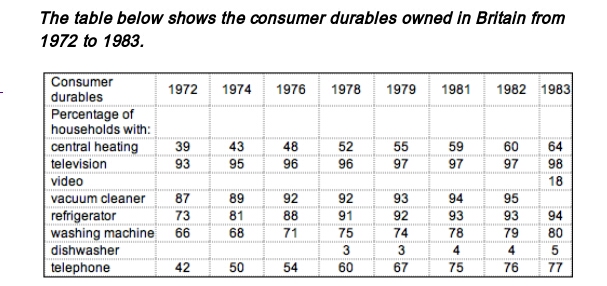The table compares the percentages of British people using different durable goods such as vacuum cleaner, washing
machine, etc between 1972 and 1983.
Throughout the period shown, the most used equipment was television in each year. However, there was a marked increase in the popularity of other consumer durables, particularly using telephone and central heating.
In 1972, 93% of British home had a television and this result increased to 98% in 1983. The majority of people also had vacuum cleaner and refrigerator. These durable goods were owned by over 30% of households by the end of the period.Washing machines were the fourth most common equipment, with 66% of households in 1972, rising to 80% of households in 1983.
By contrast, less than 40% of home had a central heating in 1972 and this item increased dramatically, with more
than 60% of households to 1983. In the first year, 42% of British families had telephone and again this equipment increased fast to 77% of
household as well as central heating at the end of the year.
machine, etc between 1972 and 1983.
Throughout the period shown, the most used equipment was television in each year. However, there was a marked increase in the popularity of other consumer durables, particularly using telephone and central heating.
In 1972, 93% of British home had a television and this result increased to 98% in 1983. The majority of people also had vacuum cleaner and refrigerator. These durable goods were owned by over 30% of households by the end of the period.Washing machines were the fourth most common equipment, with 66% of households in 1972, rising to 80% of households in 1983.
By contrast, less than 40% of home had a central heating in 1972 and this item increased dramatically, with more
than 60% of households to 1983. In the first year, 42% of British families had telephone and again this equipment increased fast to 77% of
household as well as central heating at the end of the year.

PicsArt_139542651337.jpg
